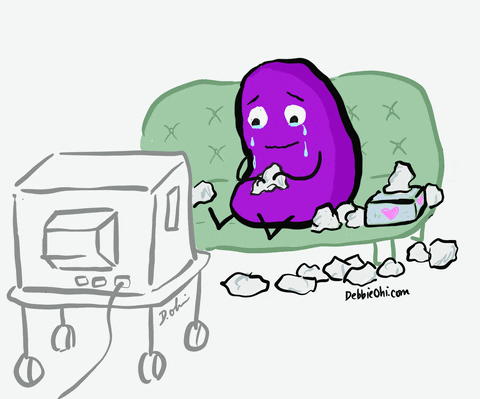My massage therapist pressed on a muscle beneath my shoulder blade, and I could feel it—that sudden surge of emotion that meant I was gonna cry. On the table, face in the cradle, I let it out.
Later, I was at home watching a movie and felt inundated with all the father/kid relationship themes, during the anniversary of my own dad’s passing. So I gave myself space to weep sitting alone on my couch.
Do you give yourself room to cry it out? Or do you avoid it?
I’ll share something that you might not expect—I kind of love to cry.
 Credit: @inkygirl
Credit: @inkygirl
Let me be clear that I don’t love having REASONS to be sad. But when I am, I kind of enjoy the feeling of letting it out.
Every time I have a cry, I feel “better” afterward. Not better as in “cool, now things are all good!” But better as in more relaxed and at peace with what is.
Many of my clients hate crying. They apologize for it during sessions and generally try to avoid it at all costs. Some of their families even used to judge or admonish them for crying.
Did you know crying is actually good for you?
Crying is your body’s natural attempt to self-regulate and get out of the “fight or flight” nervous system response. Shedding tears also triggers your brain to release oxytocin and endorphins, aka hormones that help soothe physical and emotional pain.
Crying also can decrease cortisol (the stress hormone). After crying, the body usually feels less stressed.
 Credit: TeabagCartoon
Credit: TeabagCartoon
So why do we hate crying so much?
We can get caught up in toxic positivity or believing that things “shouldn’t” affect us. Some of us have been told that crying is weak or that being sad makes you vulnerable in a negative way.
It’s generally shaming and incorrect messages from our families and our society that turn us off from the natural impulse to cry. Parents who haven’t ever learned how to be with their feelings often will push their kids away from their own emotions.
You can learn to (sort of) love crying, too.
Being around people who have a good relationship with their emotions, or working with a trauma-informed therapist, can give you a safe space to let those feelings out.
One of my clients has told me that he feels more open to experiencing his sadness and crying now that I’ve shared that I cry at least a few times a month. It felt more normal and safer to him once he knew that I do it, too.
Now he’s more connected to his feelings and he doesn’t “lose“ himself or fall into brain fog anymore. He feels more competent to weather difficult experiences in his company because he knows he will be able to process his emotions rather than getting stuck or shutting down.
Getting more in touch with your tears isn’t something you should expect yourself to do alone.
When our patterns have been created by other people, they also need to be healed with other people. Consider working with an expert like a therapist or me, or think about joining Soul School, where other people wanting to find calm will gather to support each other under my guidance.
